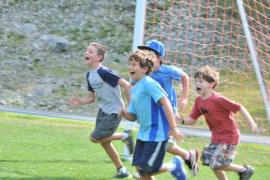Sunshine is synonymous with camp. It can be healthy, and it can lift your spirits — but the sun can also be dangerous.
Sunlight produces ultraviolet (UV) rays, which can lead to changes in the skin. Excessive or even modest sun exposure can cause skin damage, which can present as a tan or as a sunburn. Sun exposure can lead to premature skin aging, visual changes in freckles and moles, and even skin cancer. Thanks to a warming climate and a thinning ozone layer, skin cancer is on the rise and now being found in younger and younger people. Sun damage can occur in any skin type — whether you are fair or dark-skinned.
Sun exposure can be sneaky, especially while in the camp setting. Cloudy days still put you and your campers at risk for UV rays and subsequent sun damage.
So how can you help to make sure that everyone has a safe and fun summer in the sun?
- Start each day with a sunscreen routine. Make sure that you set the ground rules for your campers early so that sunscreen application simply becomes a part of the camp morning, like brushing teeth. Apply sunscreen liberally and all over, regardless of the weather. Ensure that your sunscreen is “broad spectrum” with both UVA and UVB protection. A general rule is a quarter-sized amount of sunscreen per limb or for the entire face/neck. Don’t forget sneaky areas such as ears and feet. If you’re on the water all day, try a zinc stick for your nose. Some of these sticks come in fun colors to make a sun-safe statement. Remind your fellow staff and campers to reapply sunscreen every few hours, especially if you’ve been swimming or sweating. Make it fun! Put on music, lead by example, and call it the daily “sunscreen social.” Use caution when applying spray sunscreens, and always apply these in well-ventilated areas.
- If possible, try to limit the time that you are in direct sunlight (generally speaking between the hours of 10:00 a.m.–2:00 p.m.). Eat lunch and have rest hours indoors or under a canopy to stay out of the sun during peak UV exposure hours.
- Invest in a few good sun-safe clothing options. Lightweight, breathable shirts that can cover arms are really useful, especially for those in water sports. Try a neck gaiter if you’re on a boat all day. And everyone in camp should have a good hat at the ready.
- Don’t forget your eyes! Sunglasses are key to preventing sun exposure to your retinas and eye irritation caused by the sun. Make sure that your sunglasses are the kind that provide UV protection.
- Camps generally make sure that they have a number of shaded areas and cooling stations to provide adequate breaks from the sun. These locations around camp are key to maintaining a healthy campus, and you should take advantage of them.
- Hydration is another key to success in the sun. Take frequent water breaks and breaks with electrolyte drinks on very hot and humid days to ensure your well-being and that of your campers.
What happens if you follow sun safety protocols but still end up getting burned?
Immediately attend to any sunburns. Start by hydrating — both the damaged skin topically and by mouth. Burns, especially severe ones, can impact your overall hydration and electrolyte balance. Next, it is crucial to get out of the direct sun! Adjust activities if necessary to allow for a complete sun break. Cover the damaged skin with ventilated but sun-protective clothing. Placing aloe gel on sunburned skin is helpful, as are cool ice packs. If the skin is blistered or open, make sure the health center staff examines the affected areas daily to ensure they are properly healing. Significant sunburns may require dressing. Health staff can also alert parents to any significant camper sunburns.
Finally, make sure to use sunscreen liberally once the skin has closed to prevent future burns and scarring.
The best parts of camp usually happen under the bright summer sun. Take these extra steps to maintain a sun-safe and healthy summer — doing so is key to camper success as well as yours.
Jane Glazer, MSN, MA, CPNP, FNP-BC, has practiced in urgent care, college health, and residential camp health. She is interested in education, evidence-based best practices, and providing care to campers in a safe and fun way.

